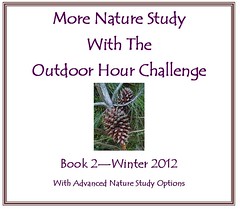"Many times children are familiar with trees in spring, summer, and autumn but they have no knowledge of them in winter; yet trees in winter give much delight to those who know them as they do in summer. Oftentimes I have gone out on a winter day with my botany can and filled it with twigs for the pleasure that the colors and form gave me.More Nature Study Book #2
Home Nature-Study Course, Cornell University 1906
Winter Tree Study - Twigs
Inside Preparation Work:
1. Read the Tree Study section staring on page 623 in the Handbook of Nature Study (Lesson 172). Pay special attention to #3 in the section on Winter Work. Take note of the lesson’s observation suggestions to keep during your nature study of winter twigs. You may wish to read the links in the follow-up activity and the additional links listed below before you go outdoors so you will be equipped with some vocabulary to use casually during your observations.
2. Optional reading if you have access to a willow tree: Read Lesson 179 in the Handbook of Nature Study (starting on page 654). Use the ideas in the lesson to study willow twigs and buds.
 |
| Advanced Study Option |
Outdoor Hour Time:
1. Outdoor time this week should include a few minutes gathering twigs. Select twigs from three different trees to take indoors for closer observation. It would be helpful to know the names of the trees you collect your twigs from but not necessary. We came inside and marked each twig with little name tags This is primarily a challenge about comparing and contrasting twigs from various trees.
2. Advanced activity: Tie a string on a twig attached to a tree. Observe and record in your nature journal the twig’s changes for a few months.
Follow-Up Activity:
1. Use the questions from Lesson 172 to get your child started making observations for each of the three twigs you collected (or just one twig for younger children). Make sure to use your sense of sight, smell, and touch to make careful observations. Record your thoughts in your nature journal or on the notebook page (ebook users only).
2. Place your three twigs on a table. How are they different? Look at size, shape, arrangement of the buds, as well as the size or shape of the buds. Compare two buds on the same twig. Can you see the leaf scars where the leaf dropped off?
3. The main parts of the twig in winter are the buds, leaf scars, and lenticels. Sketch your twigs in your nature journal or on the notebook page, drawing everything you see and labeling the parts neatly.
4. Advanced follow-up: Complete the Twig Study notebook page (ebook users). Dissect a bud from your twig and then record your observations.
Additional Websites:
Structure of a twig
An additional winter tree study challenge can be found here: Winter Tree Study (2010)
Make sure to share your January blog entries with the Outdoor Hour Challenge Blog Carnival.
You can view our twig study here: Winter Twigs - Training Our Eyes.


